FORD POLICE INTERCEPTOR UTILITY 2015 1.G Owners Manual
Manufacturer: FORD, Model Year: 2015, Model line: POLICE INTERCEPTOR UTILITY, Model: FORD POLICE INTERCEPTOR UTILITY 2015 1.GPages: 398, PDF Size: 6.24 MB
Page 111 of 398
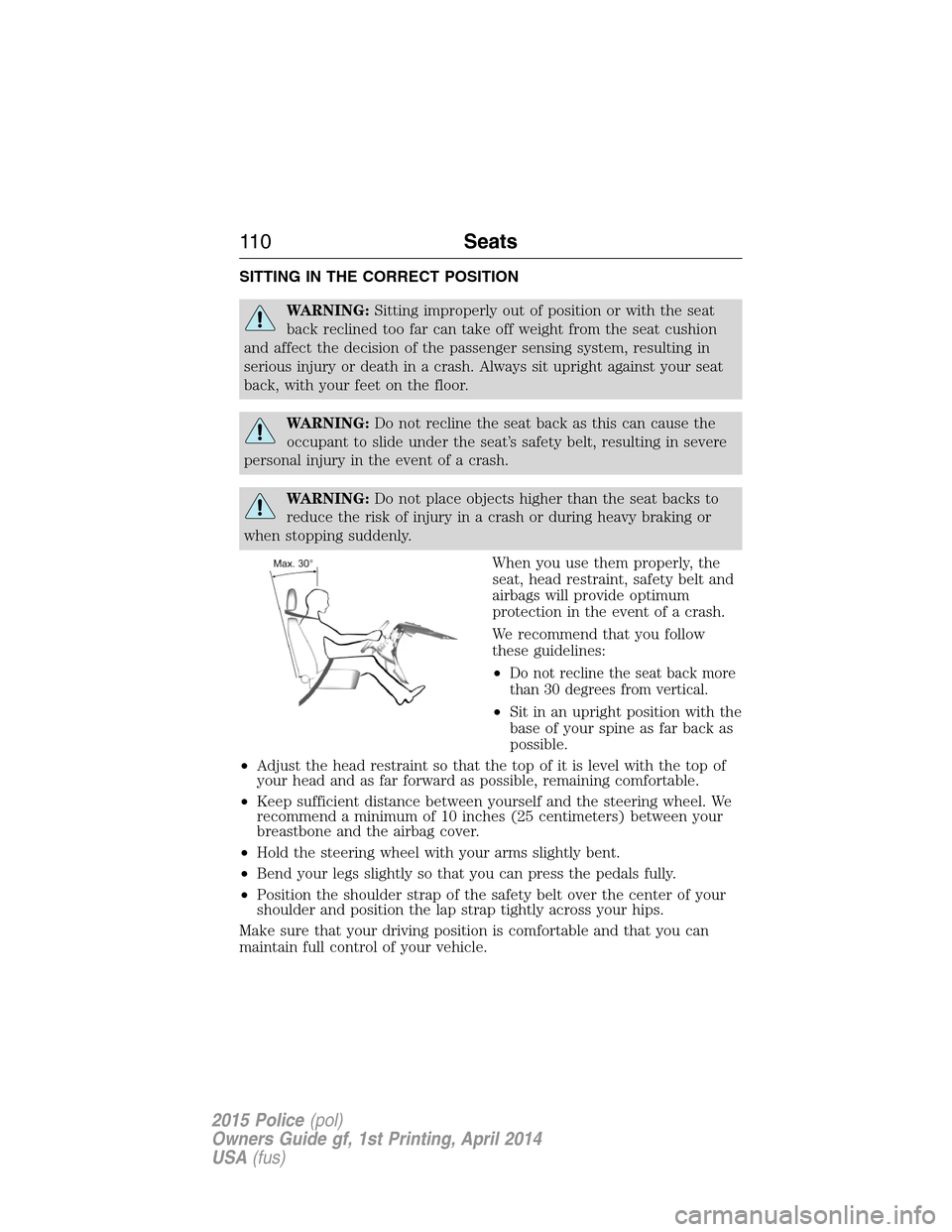
SITTING IN THE CORRECT POSITION
WARNING:Sitting improperly out of position or with the seat
back reclined too far can take off weight from the seat cushion
and affect the decision of the passenger sensing system, resulting in
serious injury or death in a crash. Always sit upright against your seat
back, with your feet on the floor.
WARNING:Do not recline the seat back as this can cause the
occupant to slide under the seat’s safety belt, resulting in severe
personal injury in the event of a crash.
WARNING:Do not place objects higher than the seat backs to
reduce the risk of injury in a crash or during heavy braking or
when stopping suddenly.
When you use them properly, the
seat, head restraint, safety belt and
airbags will provide optimum
protection in the event of a crash.
We recommend that you follow
these guidelines:
•
Do not recline the seat back more
than 30 degrees from vertical.
•Sit in an upright position with the
base of your spine as far back as
possible.
•Adjust the head restraint so that the top of it is level with the top of
your head and as far forward as possible, remaining comfortable.
•Keep sufficient distance between yourself and the steering wheel. We
recommend a minimum of 10 inches (25 centimeters) between your
breastbone and the airbag cover.
•Hold the steering wheel with your arms slightly bent.
•Bend your legs slightly so that you can press the pedals fully.
•Position the shoulder strap of the safety belt over the center of your
shoulder and position the lap strap tightly across your hips.
Make sure that your driving position is comfortable and that you can
maintain full control of your vehicle.
11 0Seats
2015 Police(pol)
Owners Guide gf, 1st Printing, April 2014
USA(fus)
Page 112 of 398
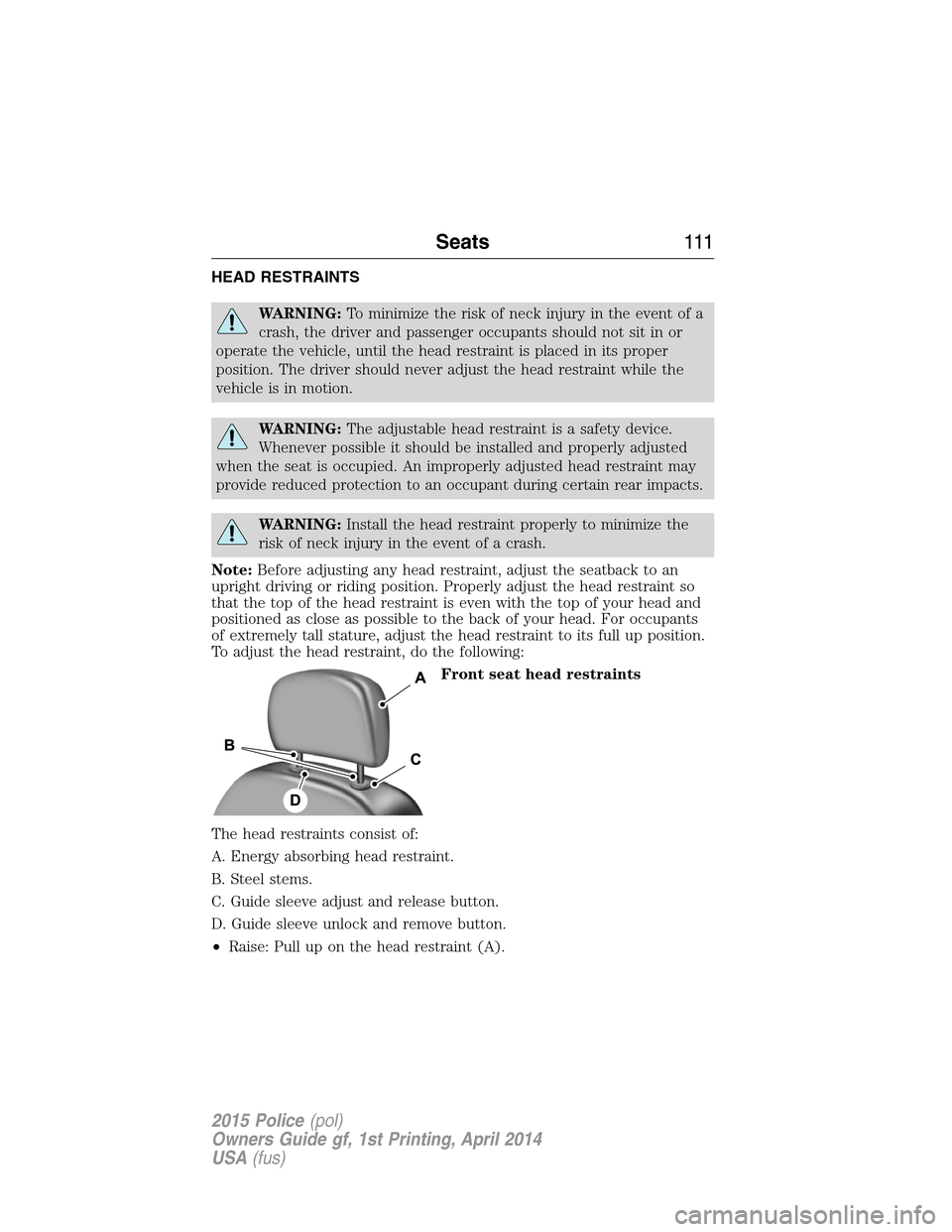
HEAD RESTRAINTS
WARNING:To minimize the risk of neck injury in the event of a
crash, the driver and passenger occupants should not sit in or
operate the vehicle, until the head restraint is placed in its proper
position. The driver should never adjust the head restraint while the
vehicle is in motion.
WARNING:The adjustable head restraint is a safety device.
Whenever possible it should be installed and properly adjusted
when the seat is occupied. An improperly adjusted head restraint may
provide reduced protection to an occupant during certain rear impacts.
WARNING:Install the head restraint properly to minimize the
risk of neck injury in the event of a crash.
Note:Before adjusting any head restraint, adjust the seatback to an
upright driving or riding position. Properly adjust the head restraint so
that the top of the head restraint is even with the top of your head and
positioned as close as possible to the back of your head. For occupants
of extremely tall stature, adjust the head restraint to its full up position.
To adjust the head restraint, do the following:
Front seat head restraints
The head restraints consist of:
A. Energy absorbing head restraint.
B. Steel stems.
C. Guide sleeve adjust and release button.
D. Guide sleeve unlock and remove button.
•Raise: Pull up on the head restraint (A).
Seats111
2015 Police(pol)
Owners Guide gf, 1st Printing, April 2014
USA(fus)
Page 113 of 398
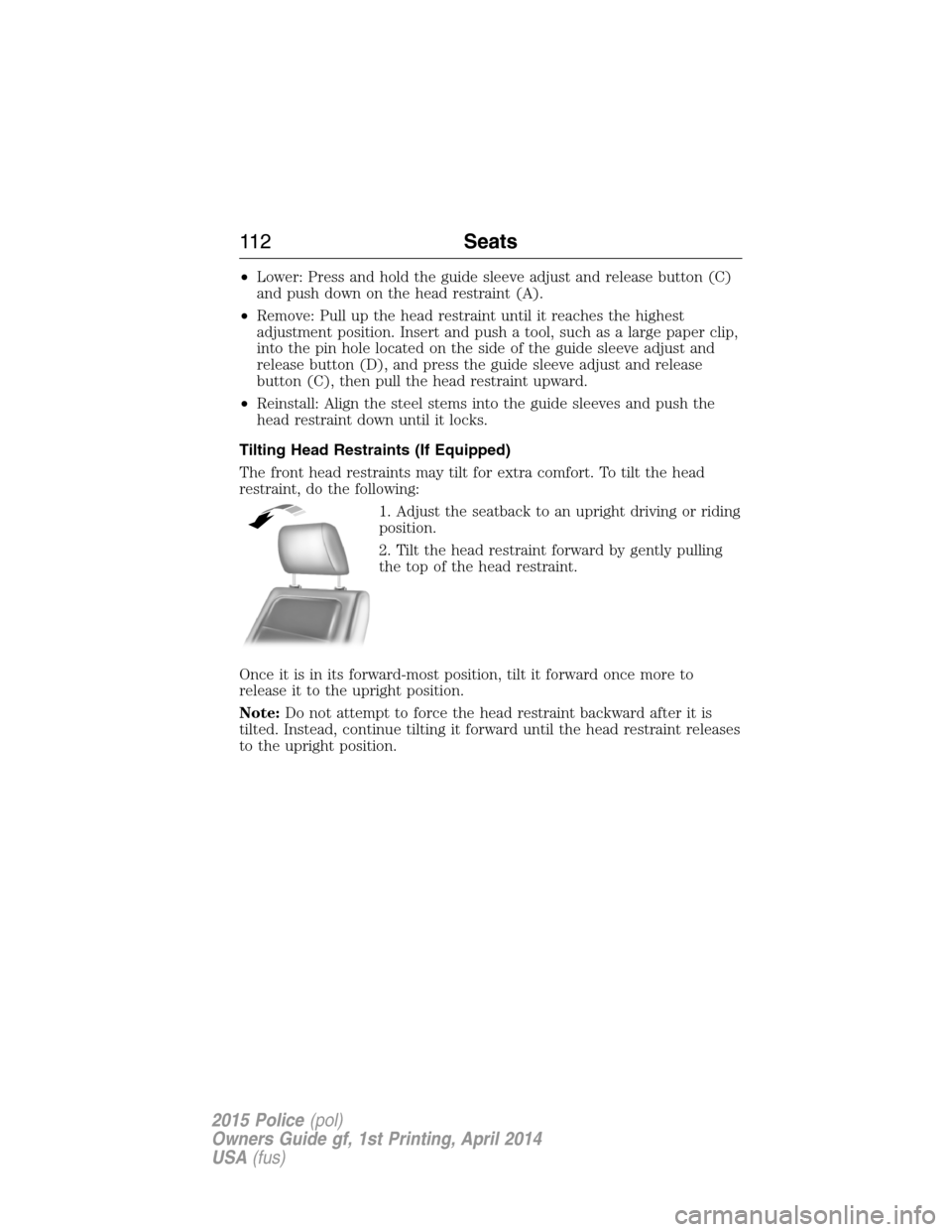
•Lower: Press and hold the guide sleeve adjust and release button (C)
and push down on the head restraint (A).
•Remove: Pull up the head restraint until it reaches the highest
adjustment position. Insert and push a tool, such as a large paper clip,
into the pin hole located on the side of the guide sleeve adjust and
release button (D), and press the guide sleeve adjust and release
button (C), then pull the head restraint upward.
•Reinstall: Align the steel stems into the guide sleeves and push the
head restraint down until it locks.
Tilting Head Restraints (If Equipped)
The front head restraints may tilt for extra comfort. To tilt the head
restraint, do the following:
1. Adjust the seatback to an upright driving or riding
position.
2. Tilt the head restraint forward by gently pulling
the top of the head restraint.
Once it is in its forward-most position, tilt it forward once more to
release it to the upright position.
Note:Do not attempt to force the head restraint backward after it is
tilted. Instead, continue tilting it forward until the head restraint releases
to the upright position.
11 2Seats
2015 Police(pol)
Owners Guide gf, 1st Printing, April 2014
USA(fus)
Page 114 of 398
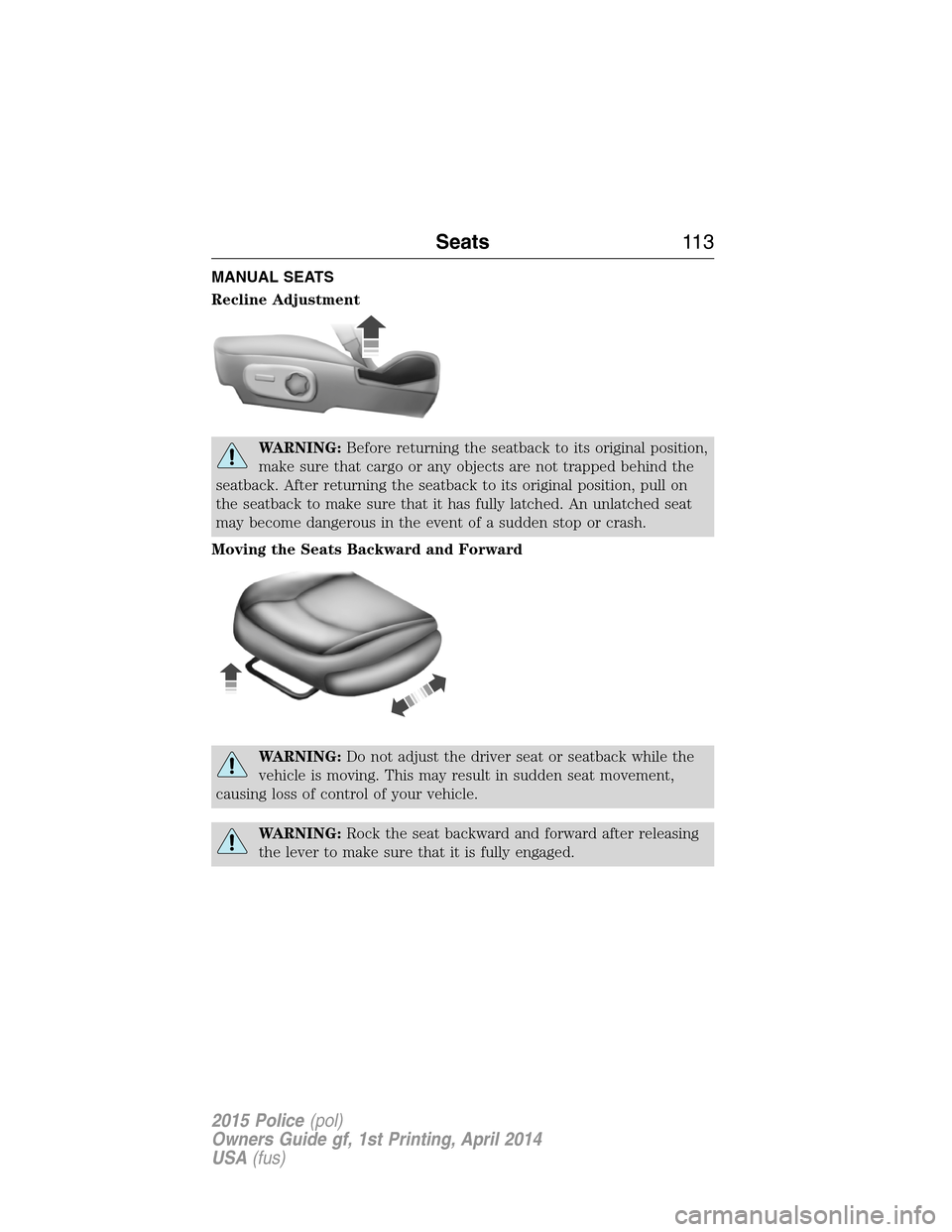
MANUAL SEATS
Recline Adjustment
WARNING:Before returning the seatback to its original position,
make sure that cargo or any objects are not trapped behind the
seatback. After returning the seatback to its original position, pull on
the seatback to make sure that it has fully latched. An unlatched seat
may become dangerous in the event of a sudden stop or crash.
Moving the Seats Backward and Forward
WARNING:Do not adjust the driver seat or seatback while the
vehicle is moving. This may result in sudden seat movement,
causing loss of control of your vehicle.
WARNING:Rock the seat backward and forward after releasing
the lever to make sure that it is fully engaged.
Seats11 3
2015 Police(pol)
Owners Guide gf, 1st Printing, April 2014
USA(fus)
Page 115 of 398
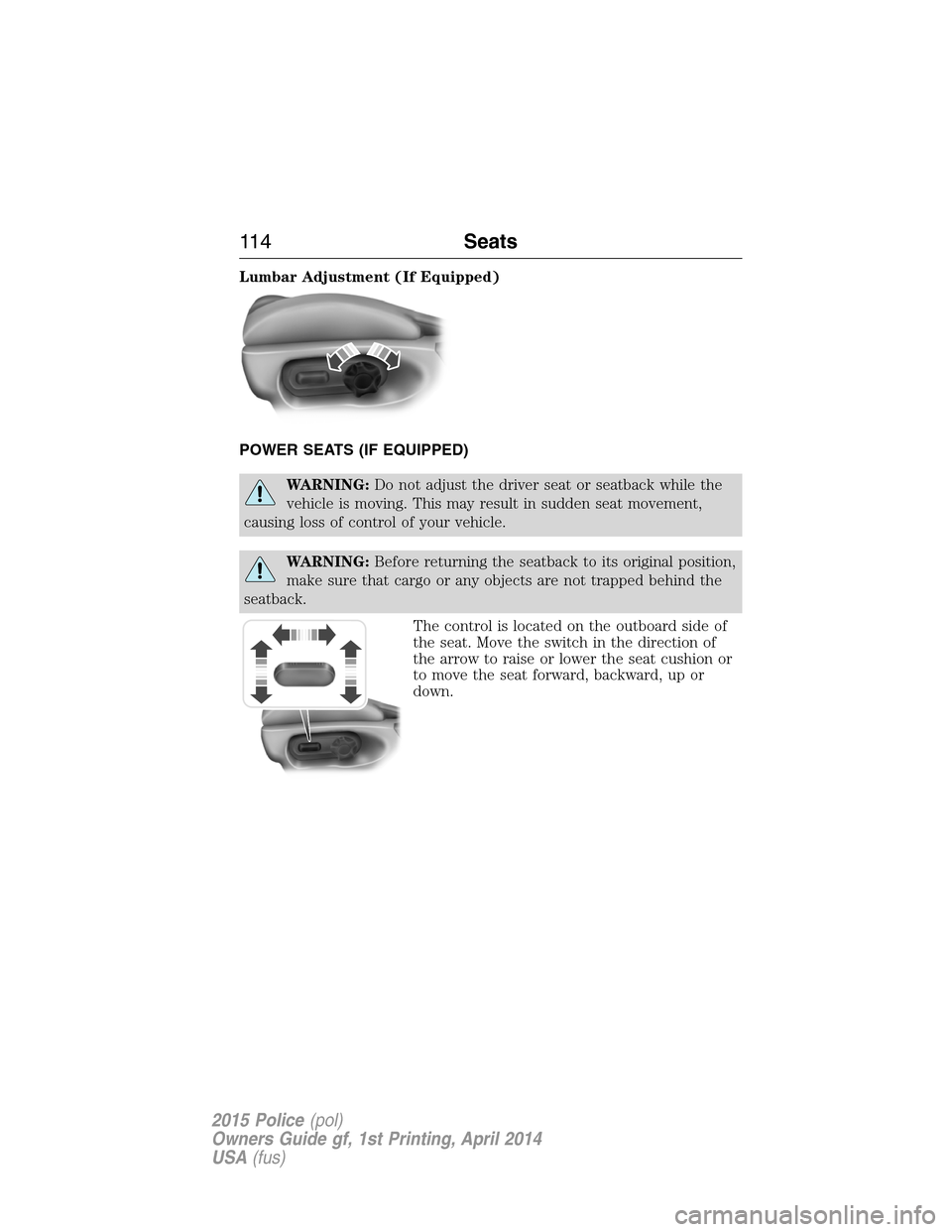
Lumbar Adjustment (If Equipped)
POWER SEATS (IF EQUIPPED)
WARNING:Do not adjust the driver seat or seatback while the
vehicle is moving. This may result in sudden seat movement,
causing loss of control of your vehicle.
WARNING:Before returning the seatback to its original position,
make sure that cargo or any objects are not trapped behind the
seatback.
The control is located on the outboard side of
the seat. Move the switch in the direction of
the arrow to raise or lower the seat cushion or
to move the seat forward, backward, up or
down.
11 4Seats
2015 Police(pol)
Owners Guide gf, 1st Printing, April 2014
USA(fus)
Page 116 of 398
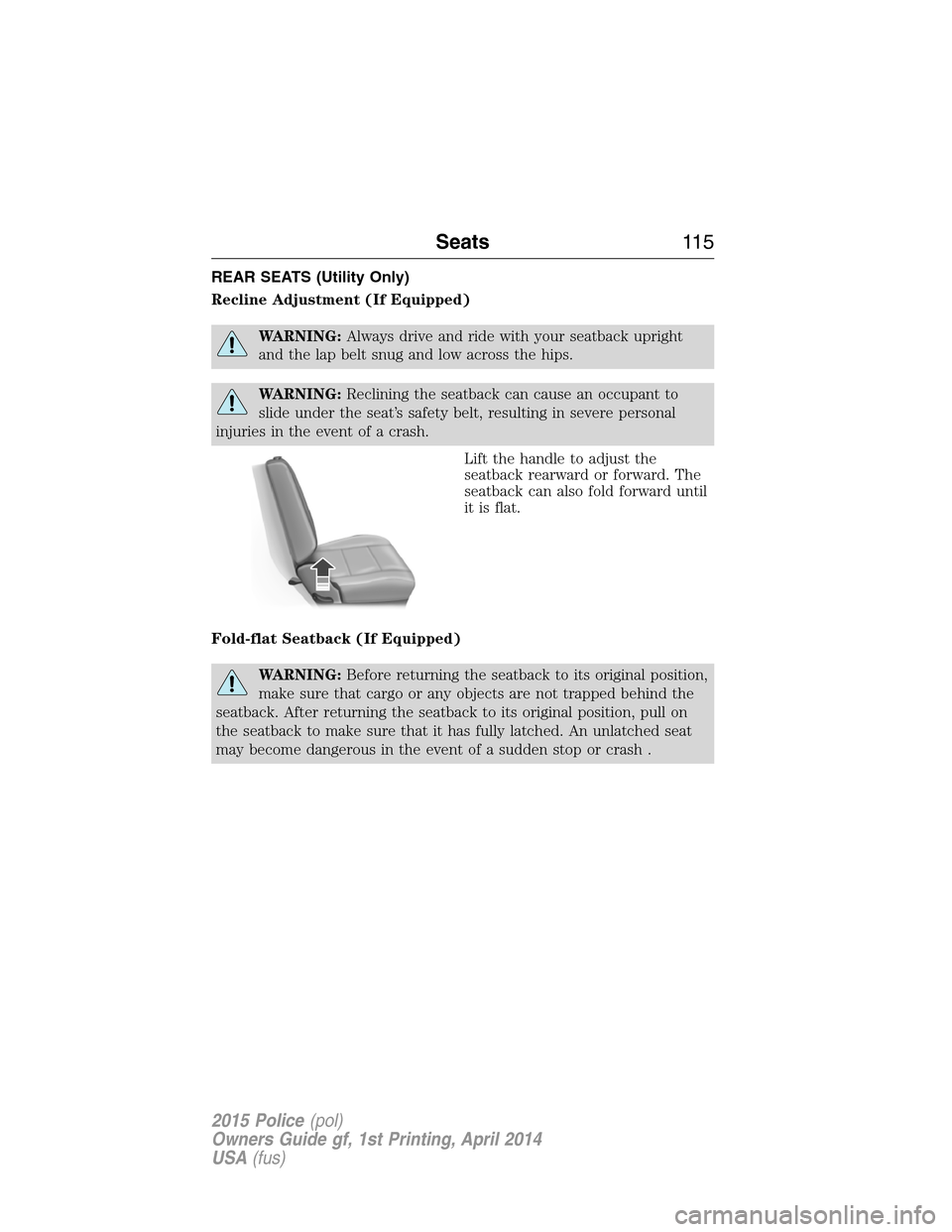
REAR SEATS (Utility Only)
Recline Adjustment (If Equipped)
WARNING:Always drive and ride with your seatback upright
and the lap belt snug and low across the hips.
WARNING:Reclining the seatback can cause an occupant to
slide under the seat’s safety belt, resulting in severe personal
injuries in the event of a crash.
Lift the handle to adjust the
seatback rearward or forward. The
seatback can also fold forward until
it is flat.
Fold-flat Seatback (If Equipped)
WARNING:Before returning the seatback to its original position,
make sure that cargo or any objects are not trapped behind the
seatback. After returning the seatback to its original position, pull on
the seatback to make sure that it has fully latched. An unlatched seat
may become dangerous in the event of a sudden stop or crash .
Seats11 5
2015 Police(pol)
Owners Guide gf, 1st Printing, April 2014
USA(fus)
Page 117 of 398
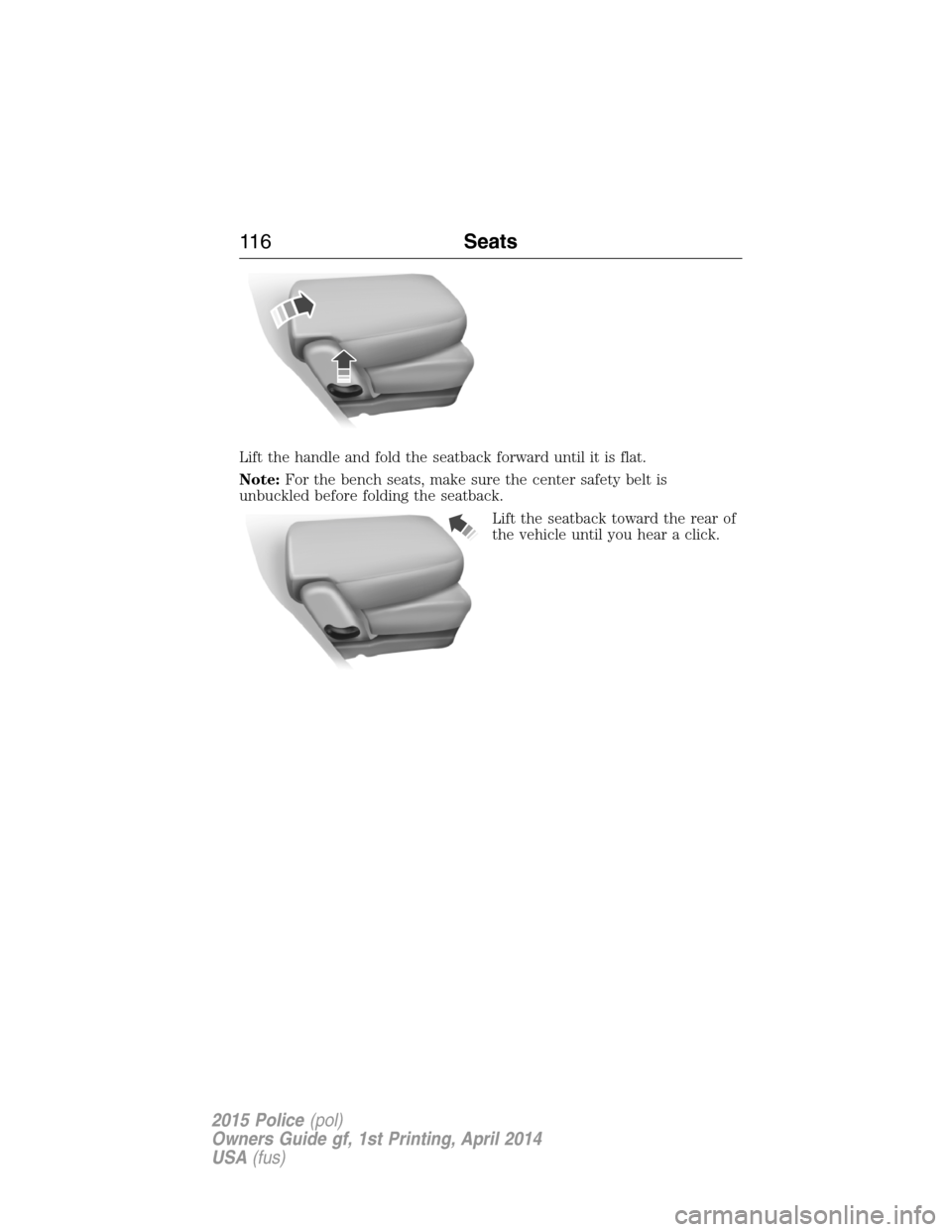
Lift the handle and fold the seatback forward until it is flat.
Note:For the bench seats, make sure the center safety belt is
unbuckled before folding the seatback.
Lift the seatback toward the rear of
the vehicle until you hear a click.
11 6Seats
2015 Police(pol)
Owners Guide gf, 1st Printing, April 2014
USA(fus)
Page 118 of 398
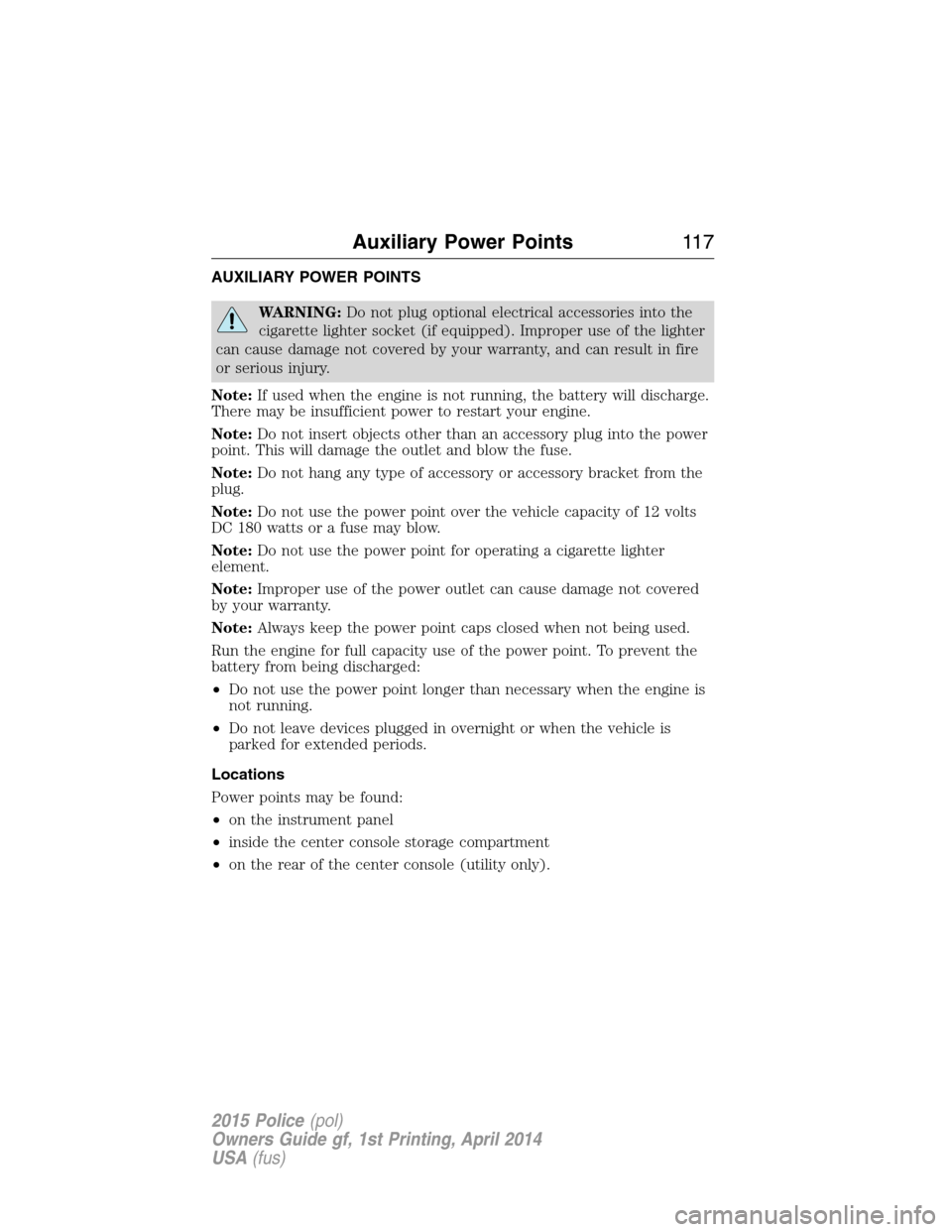
AUXILIARY POWER POINTS
WARNING:Do not plug optional electrical accessories into the
cigarette lighter socket (if equipped). Improper use of the lighter
can cause damage not covered by your warranty, and can result in fire
or serious injury.
Note:If used when the engine is not running, the battery will discharge.
There may be insufficient power to restart your engine.
Note:Do not insert objects other than an accessory plug into the power
point. This will damage the outlet and blow the fuse.
Note:Do not hang any type of accessory or accessory bracket from the
plug.
Note:Do not use the power point over the vehicle capacity of 12 volts
DC 180 watts or a fuse may blow.
Note:Do not use the power point for operating a cigarette lighter
element.
Note:Improper use of the power outlet can cause damage not covered
by your warranty.
Note:Always keep the power point caps closed when not being used.
Run the engine for full capacity use of the power point. To prevent the
battery from being discharged:
•Do not use the power point longer than necessary when the engine is
not running.
•Do not leave devices plugged in overnight or when the vehicle is
parked for extended periods.
Locations
Power points may be found:
•on the instrument panel
•inside the center console storage compartment
•on the rear of the center console (utility only).
Auxiliary Power Points11 7
2015 Police(pol)
Owners Guide gf, 1st Printing, April 2014
USA(fus)
Page 119 of 398

CENTER CONSOLE (IF EQUIPPED)
Stow items in the cupholder carefully as items may become loose during
hard braking, acceleration or collisions, including hot drinks which may
spill.
Available console features include:
Sedan
A. Cupholders.
B. Utility compartment.
Utility
Available console features include:
A. Cupholders.
B. Utility storage compartment with
powerpoint.
C. Auxiliary AV connections, USB
ports and powerpoint.
Console Mounting Plates (If Equipped)
The mounting plates should only be removed and replaced during the
upfitting process. They should not be removed permanently.
Universal Top Tray
The trim on the top of the instrument panel can be removed to aid in
upfitting aftermarket accessories or mounting equipment.
B
C
A
11 8Storage Compartments
2015 Police(pol)
Owners Guide gf, 1st Printing, April 2014
USA(fus)
Page 120 of 398
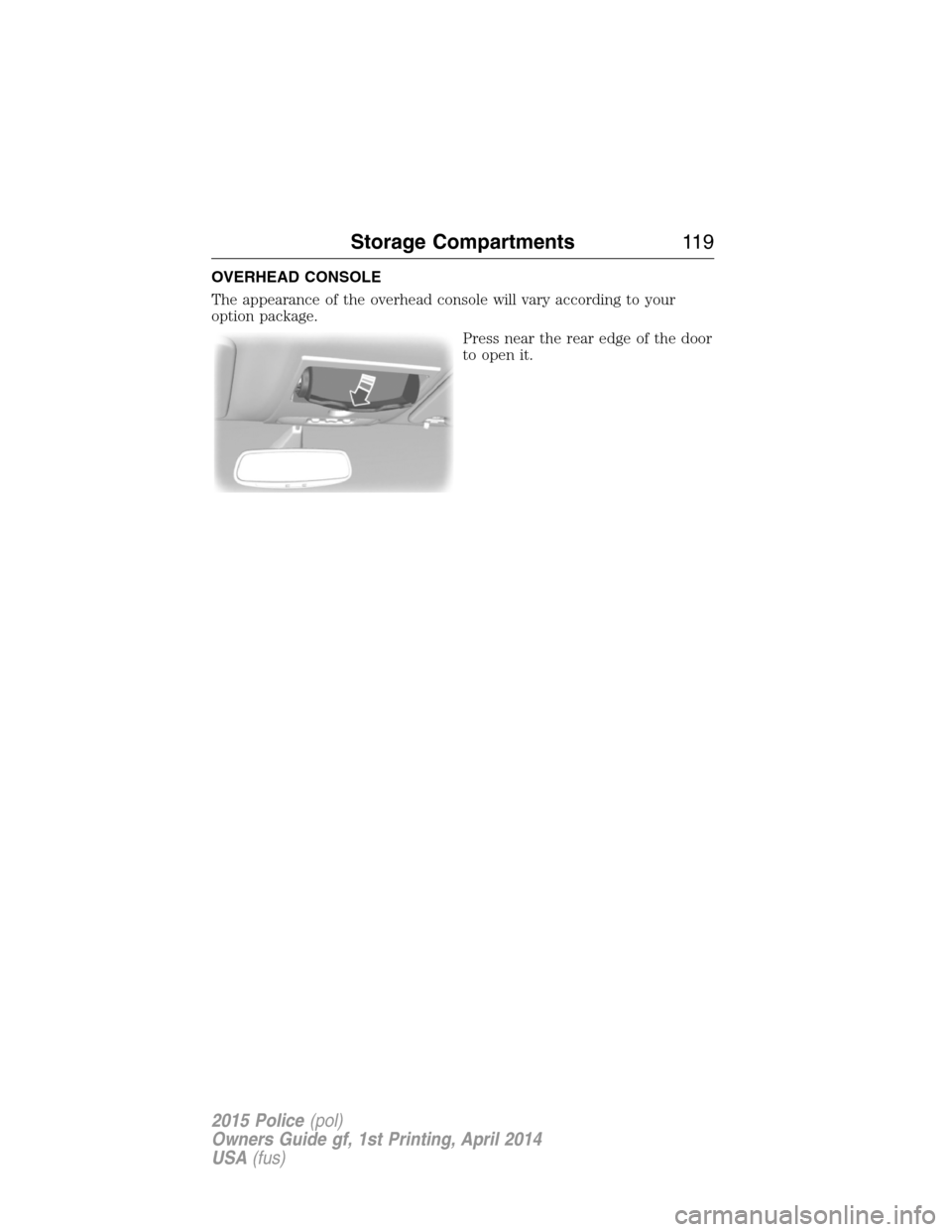
OVERHEAD CONSOLE
The appearance of the overhead console will vary according to your
option package.
Press near the rear edge of the door
to open it.
Storage Compartments11 9
2015 Police(pol)
Owners Guide gf, 1st Printing, April 2014
USA(fus)